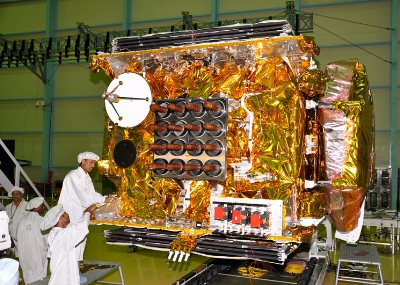India's advanced Communiation Satellite GSAT-8 successfully launched by Ariane - Video
| Watch The Beautiful Launch Of Ariane 5 carrying GSAT-8 |
It was a perfect launch. At exactly 02.08 a.m. Indian time on Saturday, from Kourou, French Guiana the 800-tonne Ariane 5 launcher carrying two communications satellites weighing over 9000 kilos in its nose fairing, blasted off into space. India’s GSAT-8, the largest and heaviest satellite built by ISRO and its partners weighing 3,100 kg , was one of the two "co-passengers" on the flight. The other, an even heavier satellite weighing 5 tonnes was from Singapore and Taiwan.
ISRO's Master Control Facility (MCF) at Hassan in Karnataka acquired the signals from GSAT-8 satellite immediately after the injection. Initial checks on the satellite have indicated normal health of the satellite. The satellite was captured in three-axis stabilisation mode. Preparations are underway for the firing of 440 Newton Liquid Apogee Motor (LAM) during the third orbit of the satellite on May 22, 2011 at 03:58 hrs IST as a first step towards taking the satellite to its geostationary orbital home.
Orbit Rising Operation Successful
The first critical orbit-raising manoeuvre of GSAT-8 was successfully conducted at 03:58 hrs (IST) this morning (May 22, 2011) with the firing of the 440 Newton Liquid Apogee Motor (LAM) on board GSAT-8 for 95 minutes by commanding the satellite from ISRO's Master Control Facility (MCF) at Hassan in Karnataka. The satellite was oriented suitably before the start of LAM operations prior to this critical manoeuvre. With this LAM operation, GSAT-8 perigee has been raised to 15,786 km. The apogee is at 35,768 km and the inclination of the orbit with respect to the equatorial plane has been reduced from 2.5 deg at the time of entering into orbit to 0.5 deg now. The present orbital period is 15 hours 56 minutes.

Two channel GAGAN payload perating in L1 and L5 bands provides Satellite based Navigation services with accuracy and integrity required by the Civil aviation applications over Indian airspace.
Applauds
It is a big relief for ISRO after two of it's communication satellites got destroyed in failed GSLV launches. Speaking to The Media after the launch, Dr. Radhakrishnan said he felt "relief and happiness" but warned that "all is not over yet". "It is not enough to give birth to a baby, you must also be able to hear its heart beat. The next few days will be crucial. We will be stabilising the satellite in a geostationary orbit and that requires extremely delicate handling,” he told The HIndu. "This is another great moment for us. We lost two satellites last year in two unsuccessful GSLV missions so this in a sense makes up for that loss. The GSAT-8 is the heaviest and most powerful satellite we have ever built and Indians will be looking forward to the applications the satellite can provide such as the GPS Navigational system."
The Prime Minister Dr. Manmohan Singh has congratulated the Department of Space for the successful launch of communication satellite GSAT-8. Prime Minister rang up Space Secretary K. Radhakrishnan at the launch site and conveyed his greetings. In his message he said: “The successful launch has once again demonstrated the versatility and reliability of Indian space programme. This launch will augument communication networks in the country and help us meet the challenge of providing affordable radio and television connectivity and world class GPS services to millions of our countrymen.”
India is working on perfecting its GSLV rocket and that in a decade or so India might not be using Ariane launchers which are by far the most relaible launcher.
GSAT -8
 |
|
Isro Scientists Working on GSAT -8 Image : ISRO |
GSAT-8, India’s advanced communication satellite, is a high power communication satellite being inducted in the INSAT system. Weighing about 3100 Kg at lift-off, GSAT-8 is configured to carry 24 high power transponders in Ku-band and a two-channel GPS Aided Geo Augmented Navigation (GAGAN) payload operating in L1 and L5 bands.
The 24 Ku band transponders will augment the capacity in the INSAT system. The GAGAN payload provides the Satellite Based Augmentation System (SBAS), through which the accuracy of the positioning information obtained from the GPS Satellite is improved by a network of ground based receivers and made available to the users in the country through the geostationary satellites.
